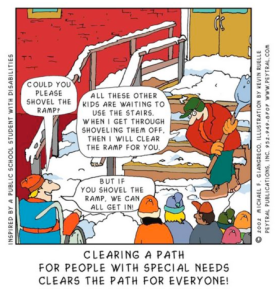A recent NPR article entitled, 5 Lessons Education Research Taught Us in 2014, seems to have a lot of definitive answers about our currently polarized educational climate. The article mentions a research paper which encourages the use of teacher-directed, explicit instruction of mathematical computation skills for procedural fluency with students with mathematical difficulties. To me this read as favoring explicit instruction and direct modeling of mathematics for students with disabilities over the project or problem-based, hands-on (manipulatives), collaborative (student-led), investigative style instruction that makes up some “reform” mathematics curriculum.
As a counterpoint to the NPR article, the National Council of Teachers of Mathematics lists procedural fluency as just one part of what is referred to as Mathematical Proficiency. In chapter 2 of the book, Achieving Fluency: Special Education and Mathematics, mathematical proficiency is discussed as including the following four components: procedural fluency, conceptual understanding, strategic and adaptive mathematical thinking, and productive disposition. Together these four components lead to mathematically proficient students which lead to mathematically proficient adults, disabilities or not.
1. Procedural fluency involves using basic skills such as facts, procedures, and formulas efficiently (i.e., quickly and accurately). It also entails knowing when to use them and, if necessary, how to adapt them. In other words, procedural fluency is skill in carrying out routines appropriately and flexibly as well as efficiently.
2. Conceptual understanding is knowledge of facts, generalizations, or principles underlying the comprehension of concepts (categories), relations (between categories), or operations (actions or events involving categories).
3. Strategic competence involves the ability to formulate, represent, and solve mathematical problems, and adaptive reasoning entails the capacity for logical thought, reflection, explanation, and justification.
4. Productive disposition entails believing that mathematics makes sense and is useful, that learning it requires diligence, and that everyone is capable of significant mathematical learning.
Since the NPR article about educational research only references one paper specifically about mathematics instruction, you only get one point of view. This NCTM book provides another viewpoint of what are important goals for mathematics lessons with struggling students.
Continue reading →

